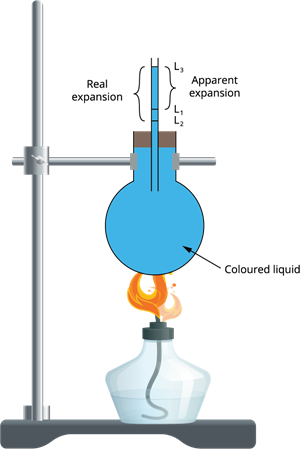
PUMPA - SMART LEARNING
எங்கள் ஆசிரியர்களுடன் 1-ஆன்-1 ஆலோசனை நேரத்தைப் பெறுங்கள். டாப்பர் ஆவதற்கு நாங்கள் பயிற்சி அளிப்போம்
Book Free DemoAn activity to understand the real and apparent expansions.
Consider a glass vessel with a long graduated stem is filled with liquid up to the mark L1.

Real and Apparent expansion
Now, the vessel is subjected to heating. It is visible that the upper level of the liquid comes down from position L1 to position L2. After that, it moves up from the graduated line L2 crossing the point L1 and reaches position L3.
The reason is that when the heat is supplied to the vessel, initially, the volume of the vessel increases. Due to this cause, liquid falls to L2 from L1.
On further heating, as soon as the liquid gets heated, its volume increases and reaches L3 from L2. It happens because the expansion of liquid is higher than the expansion of solid.
Apparently, it looks to us that the liquid was at mark L1 and finally reaches mark L3.
Therefore, L3 to L1 is the apparent expansion. L3 to L1 is the real expansion, and L1 to L2 indicates the expansion of the container.
From the above figure, we can observe that,
Distance between L3 to L2 = Distance between L3 to L1 + Distance between L1 to L2
From this, we can conclude that,
The real expansion of liquid = Apparent expansion of liquid + Volume expansion of the container